| | Korea, 2012 |
|
|
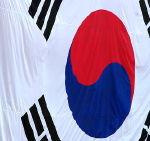
|
During the first week of August we met our Parisian friends and
in Korea. We rendezvoused in Seoul, where we toured for a couple of days, and then we moved to Daegu,
's hometown. From there, we took two excursions: an overnight trip to
Gyeongju, and a day trip to Haeinsa.
We were hosted by 's gracious and generous family: her brothers,
her sisters, and her cousin. They took us into their homes and lives. It was a once-in-a-lifetime visit!
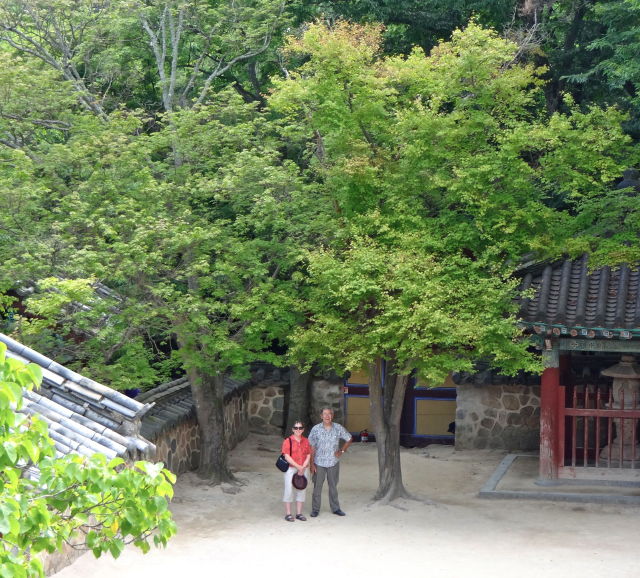
Photo : |
|
|
| Noh Hospitality |
is one of five children. Her
brothers and sisters all welcomed us and shared hosting our visit. They
are wonderful people,
and we want to introduce them ... |
|
|
|
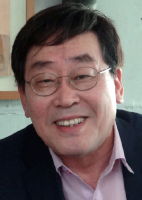 x x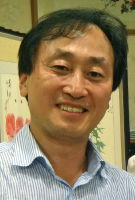 x x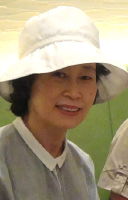 x x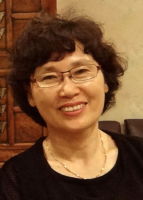 x x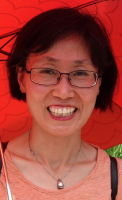
Byung Soo, Nicholas, Christina, Julianna,
|
|
|
| |
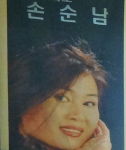 ... also welcoming and hosting us was 's cousin, Son Soon Nam. ... also welcoming and hosting us was 's cousin, Son Soon Nam.
|
|
|
| Seoul |
Seoul is a modern international capital
of more than 10 million people on the Han River. In the center of town
is Gwanghwamun Square, a pedestrian mall with much public
art and many amenities. This lovely "water feature" with fountains and a
river walk is a
newly uncovered tributary to the Han.
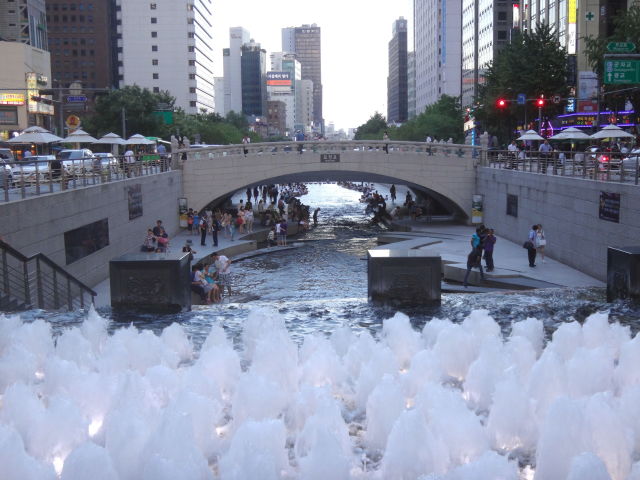
Instead of taking the river walk, turn around and see a
cluster of fountains that randomly squirt water to the delight of
children cooling off on a
hot Korean evening. 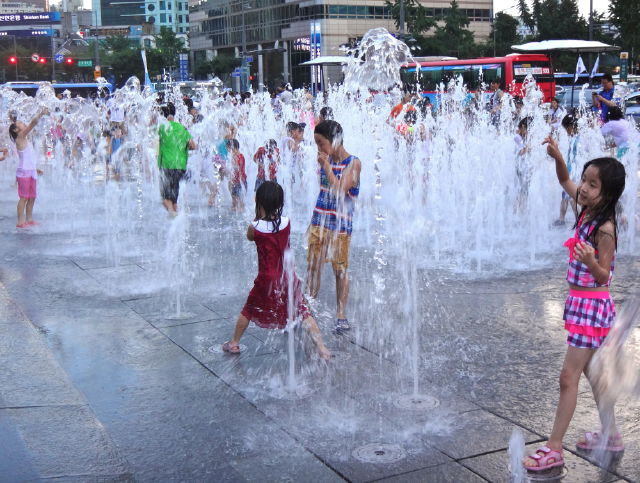
A Kid-friendly Fountain!
|
|
|
| Five Peaks |
At the entrance to Insadong -- an important shopping district in Seoul -- is a mosaic of the "Five Peaks." This
design was painted on a screen placed behind the king's throne during the 500-year Joseon Dynasty
(1392-1897). The sun and moon represent the king and queen, and the peaks the mountainous domain of Korea. We saw
this scene frequently during our visit, including behind the throne
at the restored Gyeongbok Palace in Seoul. 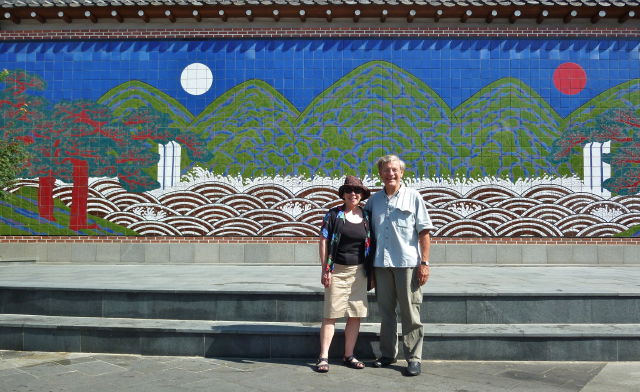
The King and Queen
|
|
|
| The Palace |
Set against the mountains, Seoul's Gyeongbok Palace was originally built in the 14th century at the start of the
Joseon Dynasty. The last emperor moved out in the 1890's. It has been destroyed and rebuilt several times.
The current reconstruction is lovely ...
|
|
|
|
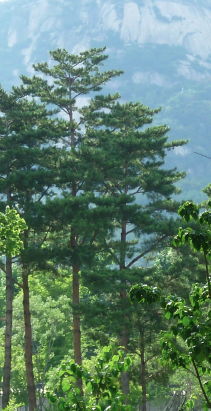 x x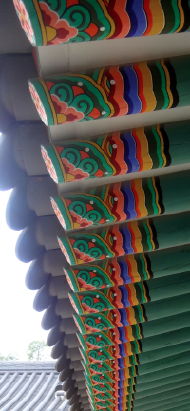 x x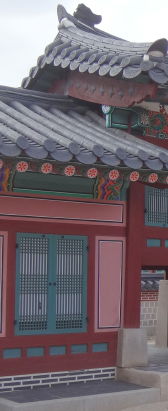 x x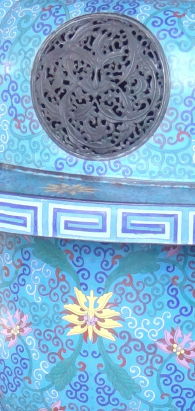
Palace Grounds Photo :
|
|
|
| |
The throne is in this building.
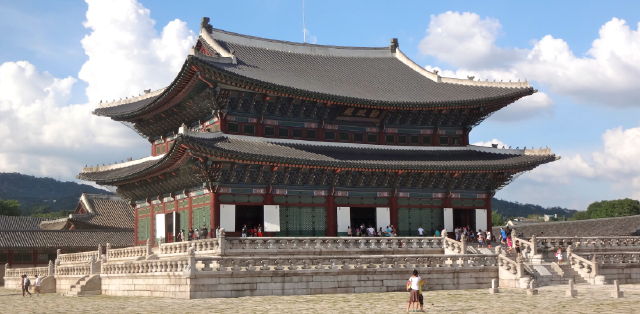
And we especially loved the Hyangwonji Garden.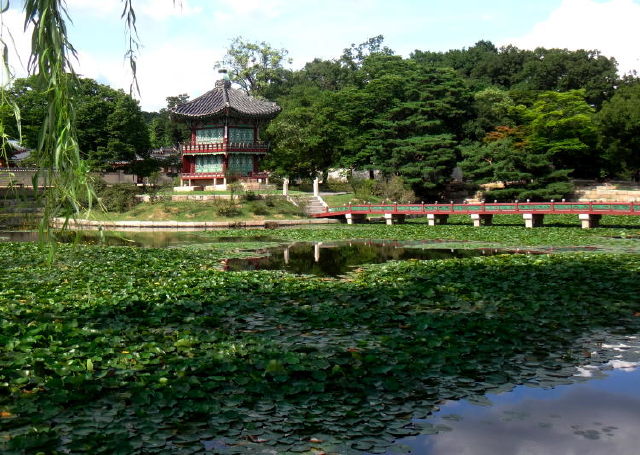
An Island of Calm In Seoul
|
|
|
| Daegu |
Daegu is southeast of Seoul, two hours by bullet train. It's Korea's third largest city.
|
|
|
| Dessert First! |
While showing us Daegu, Byung Soo took us to a charming tea house for tea and ice cream.
We chose Pine Needle Tea -- a blend of puréed pine needles and macha,
served cold. For ice cream we chose red bean served with cream over ice. Both were delicious!
 x
x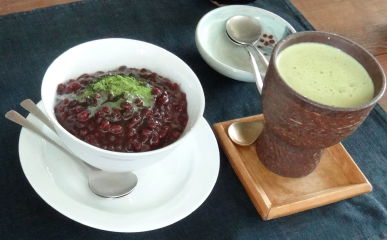
|
|
|
| Lunch 101 |
Unlike the one-plate style of American cooking, Korean cuisine is usually a "main" dish
and many side dishes and condiments. The utensils are always a long handled metal spoon
and metal chopsticks. Although many foods are spicy only rarely were they really hot. This was
a very special lunch of cured duck and vegetables.
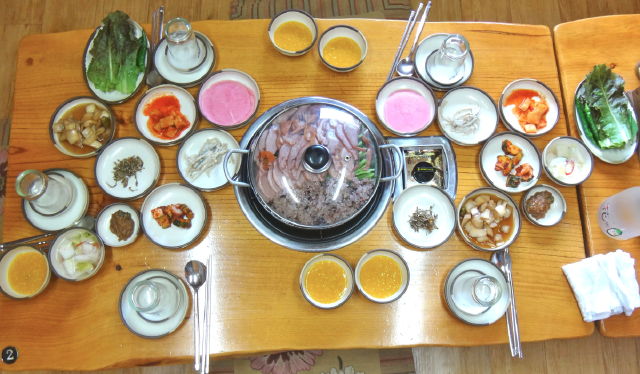
|
|
|
| Kimchi? |
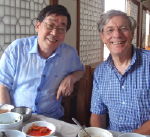 Yes. Kimchi is served often, and one common form is the familiar fermented napa cabbage in hot sauce.
But there are a hundred types of kimchi, and hundreds of other side dishes. Collectively, all
of these extra dishes are called banchan. They give meals a wide range of flavors!
Yes. Kimchi is served often, and one common form is the familiar fermented napa cabbage in hot sauce.
But there are a hundred types of kimchi, and hundreds of other side dishes. Collectively, all
of these extra dishes are called banchan. They give meals a wide range of flavors!
|
|
|
| Breakfast |
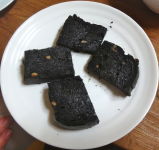 At a country inn we were served black toast. It is regular toast
made with flour containing charcoal. We could detect no taste
difference
from regular toast.
At a country inn we were served black toast. It is regular toast
made with flour containing charcoal. We could detect no taste
difference
from regular toast.
|
|
|
| |
 But our favorite
breakfast was Christina's homemade yoghurt. It was yummy! But our favorite
breakfast was Christina's homemade yoghurt. It was yummy!
|
|
|
| Traditional Remedy |
The diet seems so healthy - lots of
veggies, little meat, not much fat - it's hard to imagine that anyone
gets sick. But if they do, Daegu is famous as a
center of herbal medicine. We're not sure what all we saw in
the shops but they had a wonderful aroma.

|
|
|
| Gyeongju |
Gyeongju is an hour's drive south of Daegu, near the coast.
Between the 7th and 9th centuries, much of Korea was united
under the rule of the Silla Dynasty whose capital was Gyeongju. Today
it is home
to 31 National Treasures and several UNESCO World Heritage
Sites. With just a couple of days there, we could only skim the surface
so we kept
at it both day and night.
Among Gyeongju's treasures is this pond, now choked with
reeds, lotus
and lilies, site of the king's castle in the fifth century.
This photogenic building is "new," if you count by millennia!
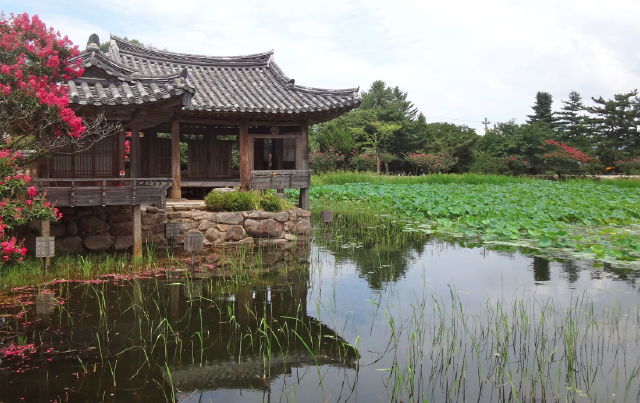
|
|
|
| Temple Guards |
The restored Bulguksa Temple was originally built in 751. These two temple guards seem to really enjoy their job.
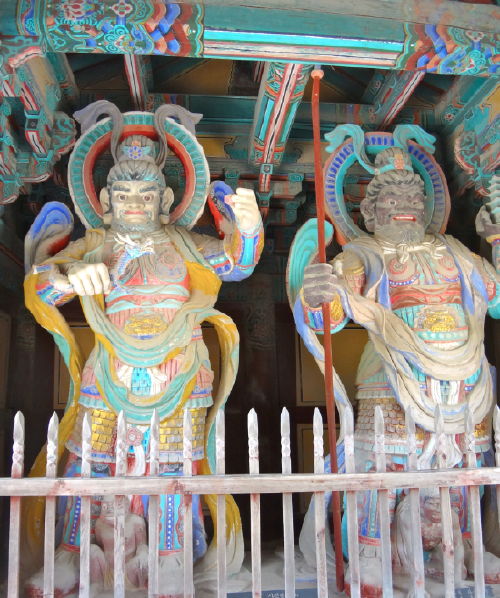
|
|
|
| Buddhist Bell |
The Seokguram Grotto is a small cave at the top of a tall mountain housing a lovely stone Buddha sculpture (no photos allowed).
Having reached the top, L had to ring the bell.
|
|
|
| Walking Tour |
A charming aspect of Gyeongju is that many sights are lighted, so they can be enjoyed at night!
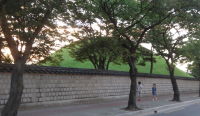 Our tour began
after dinner, as the sun was setting behind the large
mounds visible all over town. They are the burial sites of Silla Dynasty kings. Our tour began
after dinner, as the sun was setting behind the large
mounds visible all over town. They are the burial sites of Silla Dynasty kings.
|
|
|
| |
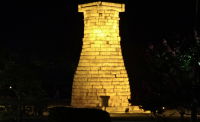 The
Cheomseongdae Observatory -- Asia's oldest -- was built in 634. We're told it's built of 361.5 stone slabs,
the number of days in a lunar year. It seemed appropriate to see it at night. The
Cheomseongdae Observatory -- Asia's oldest -- was built in 634. We're told it's built of 361.5 stone slabs,
the number of days in a lunar year. It seemed appropriate to see it at night.
Small Observatory Photo :
|
|
|
| |
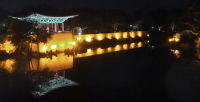 Near the
observatory, is the man-made Anapji Pond. Locals named it for the water fowl that
frequented it. The Chinese character "an" means wild goose and "ap" stands for duck. Byung Soo remembers fishing
in the pond as a boy when they visited relatives nearby. Near the
observatory, is the man-made Anapji Pond. Locals named it for the water fowl that
frequented it. The Chinese character "an" means wild goose and "ap" stands for duck. Byung Soo remembers fishing
in the pond as a boy when they visited relatives nearby.
|
|
|
| |
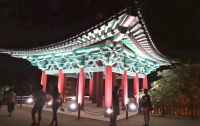 Along the banks
of the Anapji Pond the recreation of the Crown Prince's palace is underway. Along the banks
of the Anapji Pond the recreation of the Crown Prince's palace is underway.
|
|
|
|

|
|
|
| Tripitaka Koreana |
Our day trip from Daegu took us to the lovely Haein Temple, home of the Tripitaka Koreana.
It is the world's oldest, most complete
version of the Buddhist canon written in Chinese characters.
The library takes the form of 81,350 carved wooden blocks suitable for
printing.
That is, the 52,389,400 characters are carved in reverse so they print correctly.
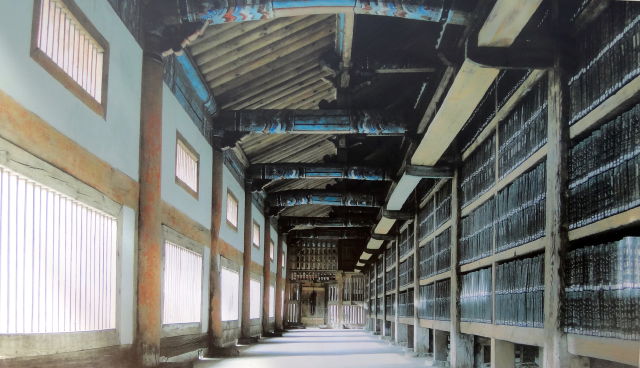
Carved between (1236-1251), each block measures approximately 70cm x 24cm (28" x 10").
Blocks are birch wood that was soaked in sea water for 3 years, and then dried in the shade (no warping!)
for three years. The blocks' detail is beautiful.
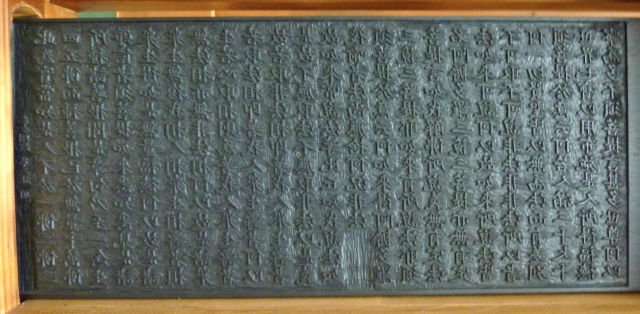
Photo :
TECHNICAL QUESTION: How did they carve 52 million Chinese
characters backwards? Begin by training many monks to write the
characters
in a consistent style. Then, they write out the sutras on
rice paper. To do a block, rub a thin coating of oil onto the birch
board, place rice paper
face down on the
board, press lightly, and the text is transferred in reverse. Next, an
expert carver carves around the letters; a beginner carver removes
the background matrix between letters.
We have a block-printed copy of this text.
|
|
|
| Amazing!!! |
As if the Tripitaka Koreana Project wasn't epic enough to amaze us, there are two other important facts.
▷ Fact 1: There are no mistakes in the 52,389,400 characters. None!
▷ Fact 2: This is the second copy! The first copy was carved in 1087, but it was destroyed by fire
in 1232 during the Mongol invasion. So, they did it again!
|
|
|
| Erratum |
Speaking of printing, we are all taught
in the West that moveable metal type was developed by Gutenberg about
1440.
In fact, movable metal type was used in Asia as early as
1234, though no book survives from that date. This is the oldest
extant book printed with movable metal type, printed in
Cheongju in 1377, that is, before Gutenberg was even born.
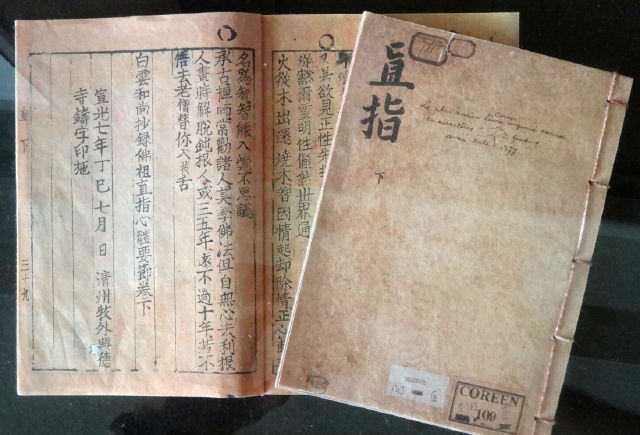
Jikji, The Oldest Book Printed With Movable Type (1377)
|
|
|
| One Of Hundreds |
Before ending, we must show this lovely painting from Haein Temple, one of
hundreds of wonderful photos we couldn't use. We can't help ourselves. It will bring you joy!

|
|
|
| Korea! |
Korea's wonderful. It makes you smile! 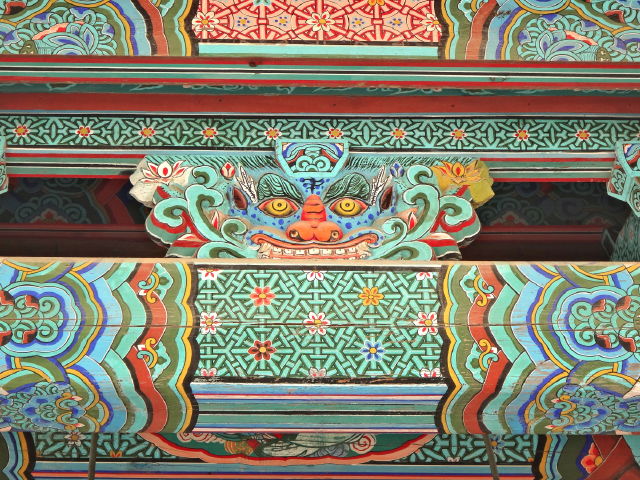
|
|
|